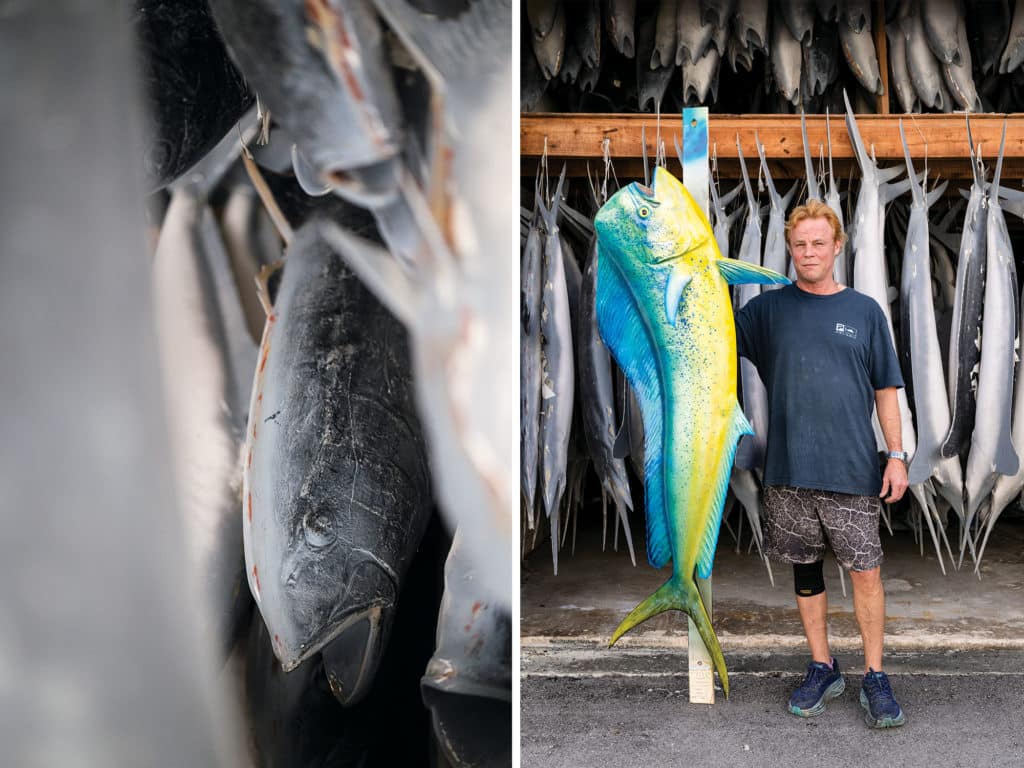
Chris Murrah is really into African pompano right now. Surfer, angler, jazz musician, and now lead painter at King Sailfish Mounts, he grew up in East Fort Lauderdale fishing on the Tarpon River. His dad was in the car business. His mom worked for St. Anthony’s school. In the mornings before school, he would hear the bait boats banging cast nets off the metal poles on the bridge behind his house. In the afternoons, when he wasn’t out playing his saxophone, catching sets off the beach, or chasing jacks and snook in the river, he liked to paint surfboards.
“I guess I always did art on my own,” Murrah says. “I’ve never taken an art class. We were just into surfing, and I was into painting, so I would paint surfboards, skateboards, T-shirts, that sort of thing. I liked painting three-dimensional objects. I never really did sit down in front of canvas, but I was always painting something. Some kind of object. Maybe that’s what drew me into painting fish.”
And paint them he does, turning dead, gray fiberglass into bright, living creatures that look like you just lifted them out of the water. He loves the challenge of it. “That pompano is like an enigma,” he says. “You can’t figure out what’s happening. It’s so chrome, yet there’s all kinds of interference. Iridescent colors flashing that you can only see at certain angles, depending on which way the light is hitting it. The color seems to dance across it.”
People are catching a lot of African pompano lately, he says, and when they do, a lot of them want them mounted. If you’ve ever seen one on the water, you’d know why. But capturing the look of a freshly caught pompano isn’t easy. “They’re almost like chrome,” Murrah says. “I think that’s the next step. Finding a way to put a chrome surface on, to have it fully chromed, and then paint over the top of it. That would be really cool.”
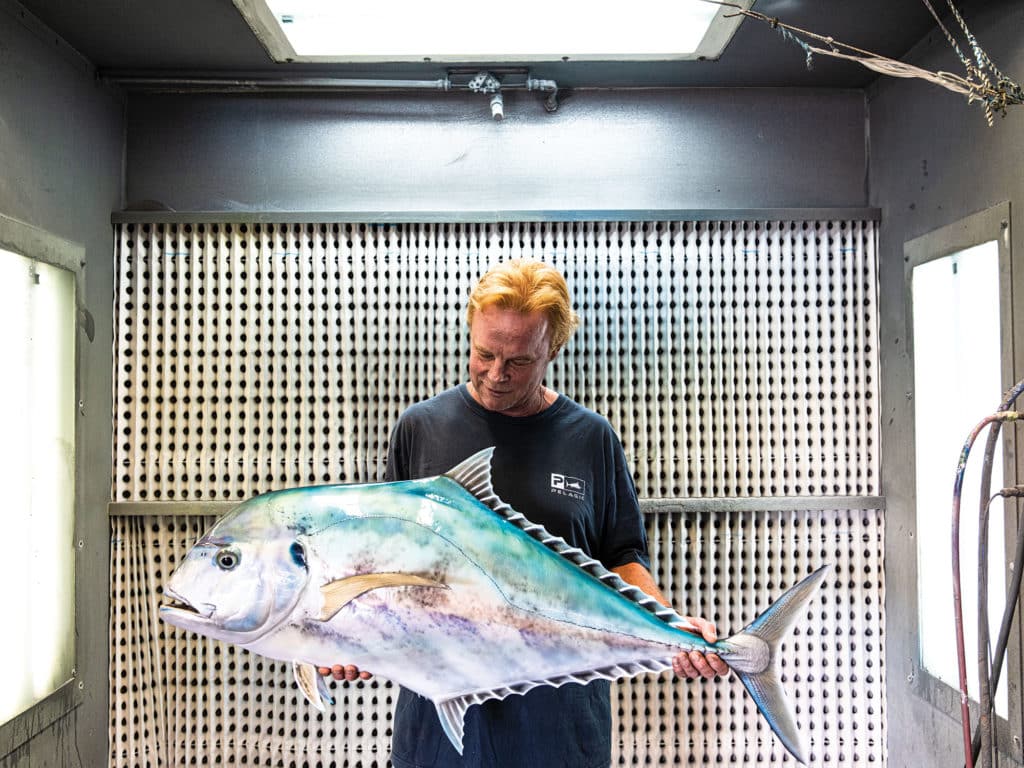
A Win for Conservation
A pioneer in the fishing business, King Sailfish Mounts got its start back in 1991, when founder Raymond “Doug” Douglas realized that selling replica mounts might be one way to put a stop to wasteful industrial taxidermy practices. Back then, most charter businesses had deals with taxidermy outfits, which would kick back big commissions to captains who could convince their sports that any moderate-size fish was worth hanging on the wall. Since all those mounts were skin mounts, all those fish were getting killed—by the metric ton. The practice had created an effective bounty on saltwater gamefish, especially in Florida—one Douglas felt was particularly damaging to local billfish. So, he decided to do something about it.
Douglas knew nothing about taxidermy, but he found a local taxidermist who was retired and taught him all about making molds. These were replica mounts, not skin mounts, that were based on angler photos—wall hangers that didn’t kill fish. He started out making a few fish in his garage, but word got out. In 1993, Guy Harvey invited him to exhibit at the Miami Boat Show. He sold over 100 mounts at that show. “That kicked the whole thing off,” Douglas says. “I had no idea I was going to be a taxidermist the rest of my life, but I spent the next 30 years doing it.” A few years ago, he was honored with the IGFA’s prestigious Conservation Award. This year, he received a Lifetime Achievement Award from The Billfish Foundation. “And in that time, we’ve saved the lives of hundreds of thousands of fish.
“When we started, almost every fish mount produced in Florida—and there were a lot of fish mounts in Florida—were based on dead fish,” Douglas says. “These days, almost every fish mount produced around the world—saltwater fish—are based on released fish.”
About a year ago, Douglas took on a partner, Daniel Miers, a former oil-industry executive. He was looking for an investor who could not only help maintain and grow the business, but also maintain and grow the mission. Miers was looking for a business that would give him purpose, and he wanted it to be about fishing, in particular marine conservation. It was a match made in heaven.
“I was the CEO of an oil and gas logistics company. I was the COO of an oil-field services company. I climbed that ladder,” Miers says. “My purpose in corporate America was to provide jobs, to provide energy to America. To me, that was a noble venture, but at the same time, where’s that satisfaction? When you can have a business that makes money, that protects the environment, and that brings joy? It’s just as good as it gets.”
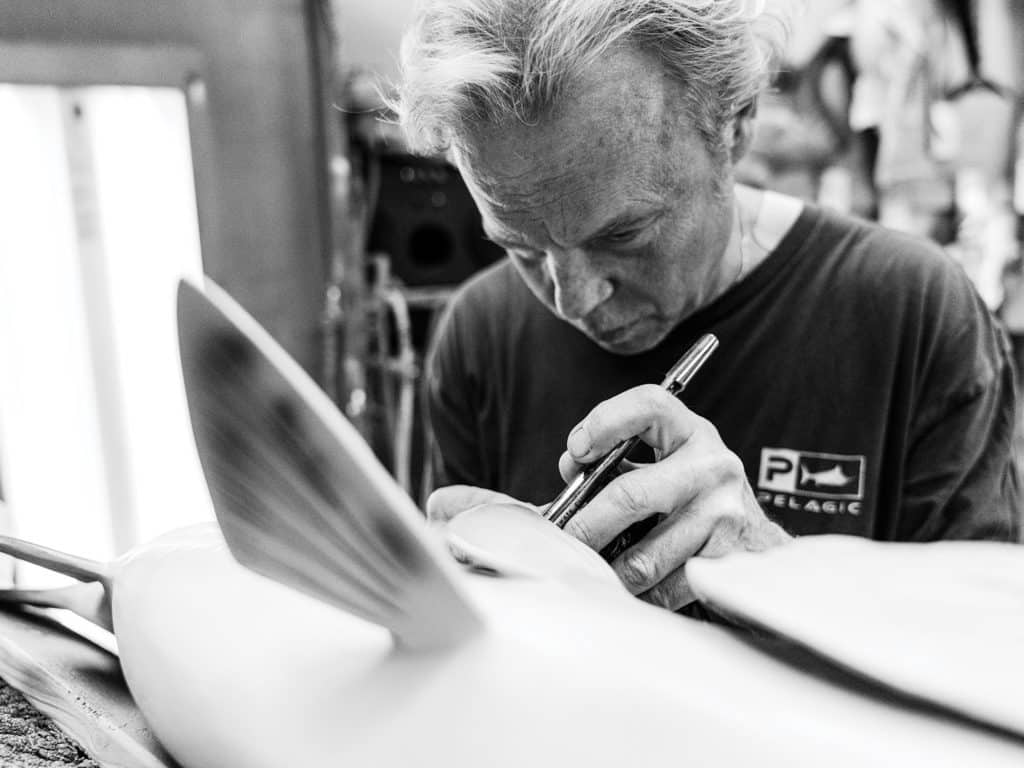
Miers sees a growth industry in replica mounts, especially with the growth of catch-and-release fishing. “I know a lot of people who are concerned that regulation is putting so much pressure on the fishing industry that they think people are getting regulated out of it. I personally think they’re looking at it wrong,” he says. “I think people are going to continue to fish, they’re just going to start letting their fish go more. Like in the state of Florida, if you catch a 40-inch redfish, you can’t keep it. You can take a picture, but if you’re really excited, and that’s the catch of a lifetime for you… In the old days, you’d bring the fish home, show it to your friends, hang it from a gin pole, whatever it was. But in 2022, what people are doing is mounting those fish. And we’ve got the technology, the talent and the ability now to make an absolute perfect representation of your fish. We get it right on the size; we get it right on the visual aspect.”
These days, King Sailfish produces between 2,000 and 3,000 replica mounts every year. “We’re focused on delivering a product that blows people’s minds, that is painted by a real artist who pours their heart and soul into it,” Miers says. “Not in assembly-line fashion. We’re not selling a tourist mount. We’re selling something for people like your subscribers. People who really go fishing, who are looking for something that represents their catch, that represents the species. So, we want it to be as accurate as possible. And I think we’ve definitely achieved that.”
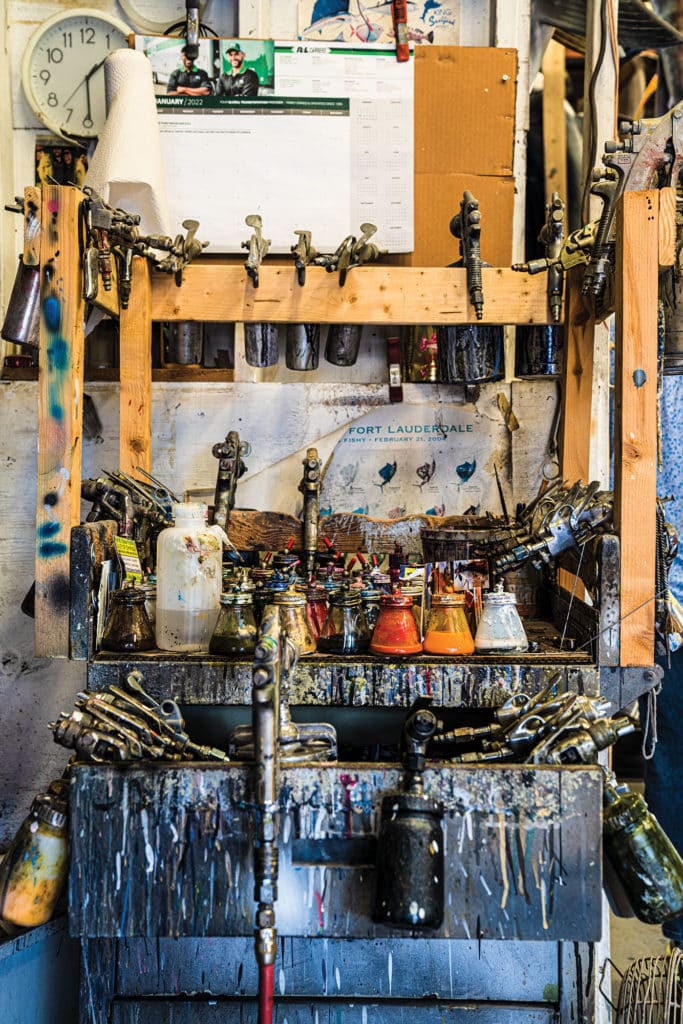
Know Your Scales
I asked Murrah how many of those few thousand fish are his. “Oh geez, I don’t know,” he says. “I’ve never really calculated that. Sometimes you’re only painting one fish a day, painting something really crazy. Other times, you can breeze through a bunch of stuff. A year? I don’t know. Maybe in the hundreds? I’d say it’s in the hundreds.”
A former music major who studied jazz in college, Murrah cranks up the tunes when he’s painting his fish. “Jazz fusion, funk, stuff like that. It keeps me going. Just turn it up and get in the zone, as we say. Get in the zone. Just go on automatic, where you’re not really thinking about what color or how do I do this; your brain is already doing all of the basics. You’re just thinking about what you’re doing overall, how to create it. You’re not thinking about the mechanics of pushing the airbrush down or mixing the color just right. It’s all ready to go.”
Kind of like playing your own instrument? “Yeah! Yeah, it’s a lot like that,” he says. “The greatest jazz musicians, you know, they go on autopilot. They’re not thinking about fingering the notes, how to blow the notes, you know. They’re thinking about telling a story when they’re improvising, so it just kind of flows out through. That’s the best feeling, when you don’t have to think about what you’re doing.”
If you’re going to improvise, though, you’ve got to know your scales. And Murrah knows his scales. I asked him what he uses for reference when he’s painting a fish. “Well, most of the time nowadays, you get a photo of the customer’s fish,” he says. “But a lot of times the photos aren’t great, or it’s a dead fish on the dock. I’m not gonna sit there and paint that.”
Murrah spends hours researching the fish he paints, especially if it’s a species he’s never done before. “We used to have a bunch of binders before you could look everything up on the internet. We’d have these binders of all the best photos from the fishing magazines, like a seatrout file with all the best magazine photos of a seatrout so you could flip through and get an idea of what you’re looking at after a while. Just the little things count. Like the yellow in the mouth. You might not see that in one guy’s picture, but he didn’t catch that one seatrout that didn’t have yellow in its mouth.”
He also studies the photos anglers send in with their fish. “A lot of times we do get a great photo, and if there’s a fish with a certain marking on it, a certain way the pattern worked on it? Like on a wahoo, the stripes are all different on every one.” Even if they’re faded, “I can see which way the stripes are going, and how they angle up at the front, how they change angles. You can do that. You can go through and paint the actual stripes, you know, the way that they looked on the guy’s actual fish.”
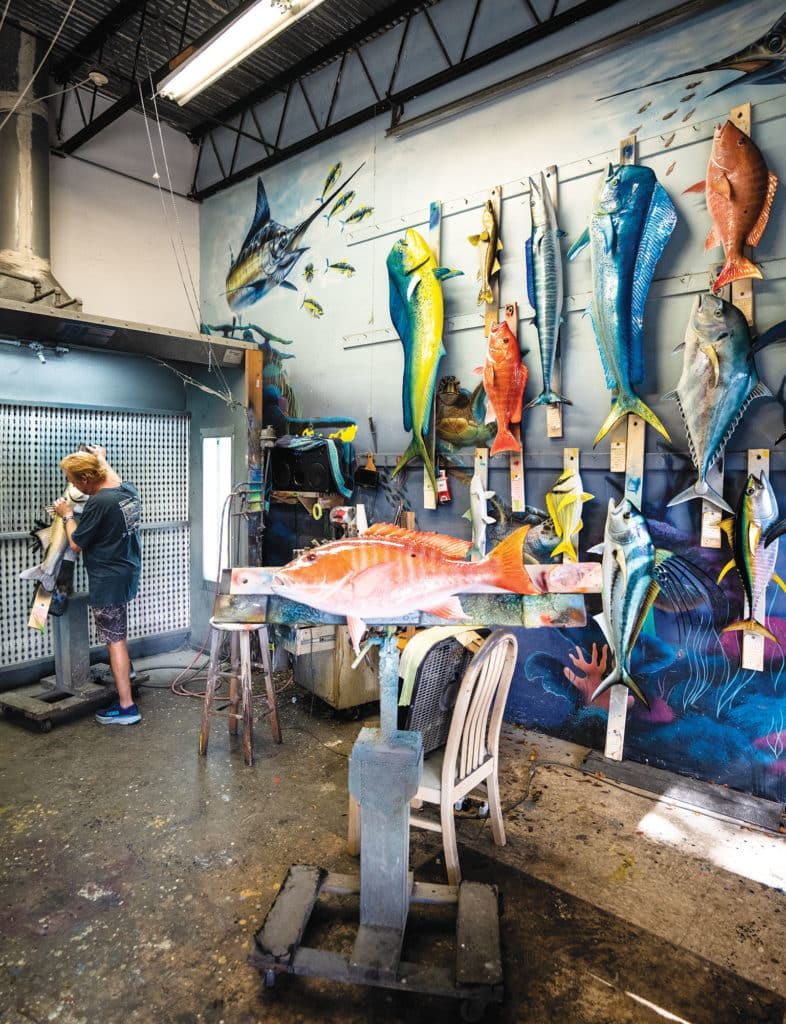
But you can’t take a photo of a fish and see everything. “You take one photo and then move a little bit and take another photo, and it looks like an entirely different fish,” he says. “When you walk by it, you can see the changing colors. That’s what really sells it. That’s the coolest thing to me, when I put it on a stand, and you walk by and you can see the fish changing. That’s cool.”
What is the hardest part of a fish to paint? “I don’t know, man. Like painting the eye or something like that? I’d have to say it’s just figuring out the pattern and how the colors work together. It’s basically just finding a balance. That’s the hardest part for me. The longer I’ve done this, the more I realize that less paint most of the time is better. You have to use the base coat, what’s underneath. We paint with transparent color, so basically what’s underneath kind of shines through. So if you use a silver base coat or gold, or you put some other iridescent colors under, you can lay the other colors on top of that. That’s how you get that brightness.
“You know, when you see a fish out in the sun, it’s the brightest thing ever. I don’t know how many layers of color—the fish, the skin, the scales. They all have certain effects on what the fish looks like. It’s just a constant battle studying all that stuff, figuring out how fish skin works. That’s what I’ve been really trying to home in on. I’ve taken a cue from the automobile guys with all the hot-rod stuff, the custom flip-flop paints and powders you can mix together to have things change colors depending on what angle you’re looking at. Trying to incorporate that over the past year or so has really stepped up our game.”
As we were wrapping up our interview, I ask, “So, what is your actual job title, anyway?” Murrah laughs. “I’m just the artist. An artist. I don’t know. Painter? How about fish painter. That’s what I’d like to be called. The fish painter.”
Read Next: Catch and Release Fishing Tips for Dummies
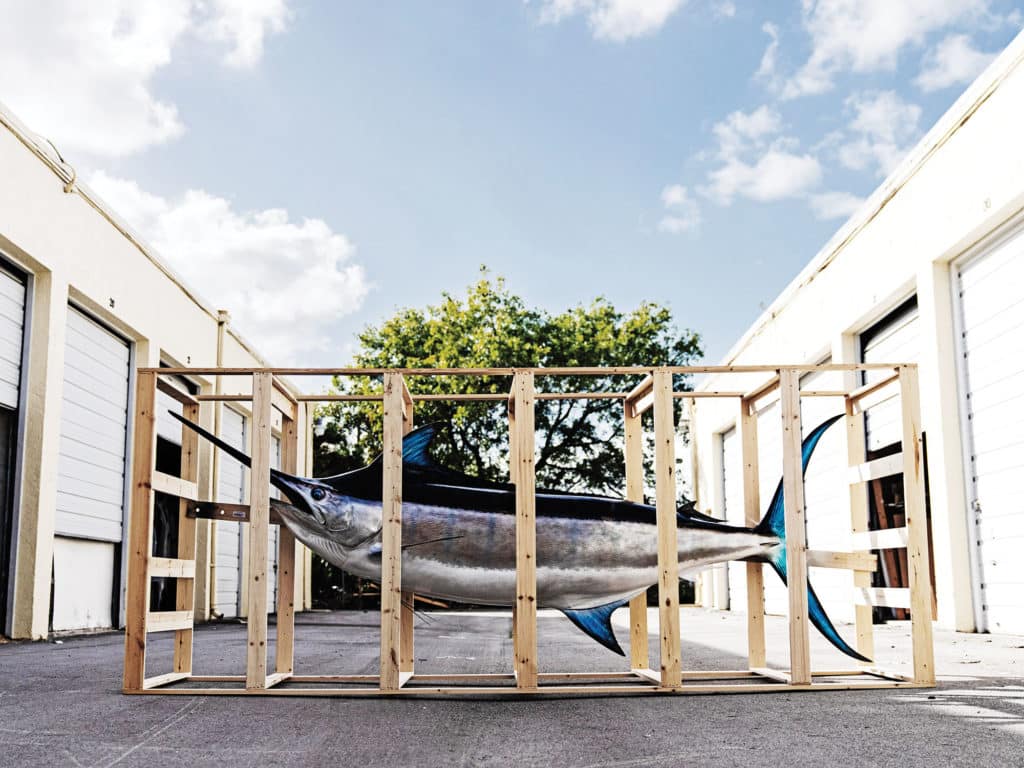
How do you handle the eyes?
“We buy these glass eyes of all sizes and different shapes and basically paint the back side of the eye, the concave part of that eye. We like to put our eyes in not just by slapping a flat eye on there but kind of sink them in a little bit, rotate them. Just so they have like a look. Those fish, their eyes can swivel around. It’s cool when you see a tuna and his eye’s got that downturned look, where he’s looking back at you. That’s the way we do it here. Just to give it some kinda character instead of [being] lifeless, you know, like a doll’s eye.” —Chris Murrah
On Making the Blanks:
“We have our molds that we use. It’s basically the same way they build boats. They put a layer of gelcoat into the mold, and then they fiberglass it. When it pops out of the mold, you have the basic shape, but you gotta cut it and trim it and shape it, you know, almost like you’re doing a sculpture. Or a surfboard! You know, shaping it, shaping the seam along the back and the stomach. Putting the fins in, making the pectoral fin have a little bit of muscle right there, where it joins in. Just sort of things like that.” Murrah uses sandpaper and orbital disc sanders. “Anything you can get your hands on to get the job done,” he says. “We use bondo to fill in the gaps in the seams, you know, fill in the low spots. Or epoxy putty. I sculpt the inside of most of the [fish] mouths we have with epoxy putty.” —Chris Murrah









